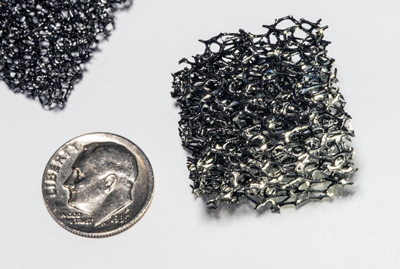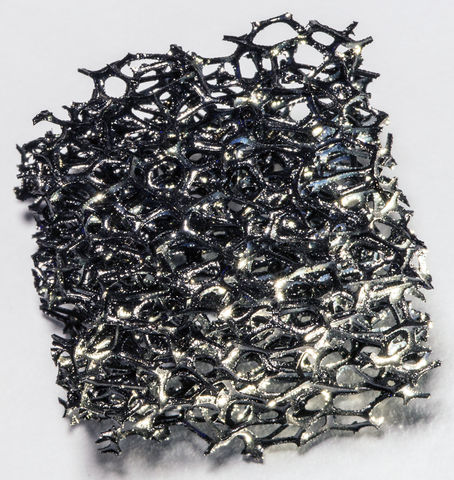A team of researchers has successfully demonstrated a new design concept for a neutron detector that does not rely – as nearly all current models do – on a dwindling worldwide supply of a very rare gas.
The animation shows how neutrons are detected by a novel device in which a boron-coated carbon foam sits in a chamber filled with xenon gas. When an incoming neutron hits a boron atom, the atom splits into pieces which travel into the xenon gas, exciting the atoms there. The excited atoms shed their energy as ultraviolet radiation, which registers in a light-amplifying device, signaling the arrival of the neutron.
Building on work reported in 2014, which showed that a process called "excimer scintillation" provides a mechanism for sensitive neutron detection, the new results reveal that a specially treated carbon foam with high surface area may hold particular promise as a critical component in the next generation of detectors.
Detecting neutrons emitted by radioactive materials is of critical importance to homeland security and counter-terrorism activities, such as screening cargo containers and identifying "dirty bomb" materials, as well as other vital applications in nuclear power instrumentation, workplace safety, industry, and science. Since 9/11, demand for detectors has risen dramatically.
Conventional detectors rely on a Geiger counter-like cylinder filled with Helium-3 (3He), a rare isotope that exhibits a distinctive reaction when struck by a neutron. Historically, the sole source of 3He has been the radioactive decay of tritium, a key component in nuclear weapons. As production of these weapons has declined over the past three decades, so has the inventory of tritium – and hence 3He. That shortage has prompted a worldwide search for another method or material to fill the gap.
That is a formidable challenge. "Detection of low-energy neutrons is called 'the dismal science' by many of its practitioners for good reason," says Charles Clark of NIST's Quantum Measurement Division. "Neutrons are, of course, electrically neutral. You can't accelerate them, and they don't generally have enough energy to excite anything. Fortunately, one way they can be detected is when they prompt a fission reaction and the reaction products interact with a surrounding noble gas."
For several years, Clark and colleagues at NIST's Physical Measurement Laboratory, the University of Maryland, and the Johns Hopkins Applied Physics Laboratory (APL) have been investigating such a method that relies on ultraviolet light emitted from atoms of xenon or other noble gases in response to by-products of a nuclear reaction between an incident neutron and an atom of boron. (See video.)
The apparatus consists of a hollow cube 7 cm on a side that is filled with xenon gas. The cell has a window to admit incoming neutrons and an attached photomultiplier tube that captures and amplifies faint UV light signals. At the center of the cell is a neutron target, or "converter," consisting of carbon foam coated with a boron-carbon compound containing some boron-10 (10B, the isotope notable for its ability to capture neutrons).
The detection process has several stages. First an incoming neutron strikes an atom of boron-10. That causes the boron atom to break (fission) into two reaction products: a lithium-7 (7Li) ion and an alpha particle made up of two protons and two neutrons. The 7Li ion and alpha particle fly off in opposite directions and, upon escaping from the target, deposit up to 2.5 million electron volts of kinetic energy into the surrounding xenon gas, exciting some of the atoms.

These excited xenon atoms temporarily bind to adjacent, unexcited atoms, forming combinations called excimers. The excimers dissociate on a time scale of nanoseconds, releasing energy in the form of far-ultraviolet (FUV) photons with wavelengths in the range of 170 nm. The photomultiplier tube captures the photons and amplifies their signal, marking the arrival of neutrons.
In their initial work, the researchers used a film of enriched 10B as the converter. It performed well, but trapped a substantial number of ions before they could escape into the gas, thus reducing the detection efficiency. "We wanted to explore what occurs when the boron is more uniformly distributed within the chamber, and reaction products have more freedom to travel," says Michael Coplan of UMD. To that end, they decided to use a three-dimensional carbon foam with much greater surface area than the two-dimensional film – a configuration they had investigated with colleagues at APL.
In the latest work, the NIST-UMD-APL team set out to determine the neutron-detection potential of carbon foam (with about 5 pores per inch; see photo at left) coated with a layer of boron carbide (B4C), an ultra-hard material used in tank armor, among other applications. The system was tested in a neutron beam at NIST's Center for Neutron Research, and the foam's ultraviolet light transmission was measured at the NIST Synchrotron Ultraviolet Radiation Facility.
The results, reported in Applied Physics Letters, were encouraging, showing a high scintillation yield from the xenon atoms and clear evidence of neutron detection. The researchers are already working to optimize the design by using an enriched foam coating. Boron-10 makes up only about 20% of boron atoms found in nature. The majority isotope, boron-11, does not have the same neutron-capture abilities.
"Our foam was coated with natural boron carbide, which absorbs five times fewer neutrons per unit length than enriched pure 10B," says APL's Christopher Lavelle, first author on the new paper. "So one obvious area of possible improvement is enriching the 10B content of the coating, and making the coating thinner.

Nonetheless, the new results plainly demonstrate that the properties of noble gas scintillation, together with careful consideration of converter geometry, may have a role to play in future research on alternatives to to helium-3-based detectors for science, industry, and homeland protection.
* An excimer (excited dimer) is a short-lived molecule formed from two atoms, one of which has its valence shell completely filled with electrons. (e.g., a noble gas.) Scintillation is the process of giving off light in response to a stimulus.
** For more information, see the Government Accountability Office Technology Assessment titled Neutron Detectors: Alternatives to Using Helium-3.

